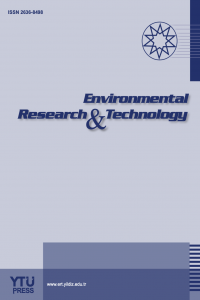Long chain fatty acid (LCFA) occurrence in primary and secondary sewage sludge fractions
Long chain fatty acid (LCFA) occurrence in primary and secondary sewage sludge fractions
Anaerobic digestion, inhibition, long chain fatty acids sewage sludge,
___
- Water Environment Federation, “Industrial Wastewater Management, Treatment, and Disposal,” WEF Manual of Practice No. FD-3, 3rd edition, Alexandria, 2008.
- G. Tchobanoglous, F. L. Burton, and H. D. Stensel, “Wastewater engineering: treatment, disposal and reuse,” Edited by Metcalf and Eddy. McGraw Hill Press, 2003.
- D. Erdirencelebi, and M. Kucukhemek, “Diagnosis of the anaerobic reject water effects on WWTP operational characteristics as a precursor of bulking and foaming,” Water Science and Technology, Vol. 71(4), pp. 572-579, 2015. [CrossRef]
- M. M. Alves, M. A. Pereira, D. Z. Souza, A. J. Cavaleiro, P. Merjin, H. Smidt, and A. J. M. Stams, “Waste lipids to energy: how to optimize methane production from long-chain fatty acids (LCFA),” Microbial Biotechnology, Vol. 2(5), pp. 538-550, 2009. [CrossRef]
- J. Palatsi, R. Affes, B. Fernandez, M. A. Pereira, M. M. Alves, and X. Flotats, “Influence of adsorption and anaerobic granular sludge characteristics on long chain fatty acids inhibition process,” Water Research, Vol. 46, pp. 5268-5278, 2012. [CrossRef]
- A. Rinzema, M. Boone, K. V. Knippenberg, and G. Lettinga, “Bactericidal effect of long chain fatty acids in anaerobic digestion,” Water Environment Research, Vol. 66(1), pp. 40–49, 1994. [CrossRef]
- M. A. Pereira, D. Z. Sousa, M. Mota, and M. M. Alves, “Mineralization of LCFA associated with anaerobic sludge: kinetics, enhancement of methanogenic activity, and effect of VFA,” Biotechnology Bioengineering, Vol. 88, pp. 502–511, 2004. [CrossRef]
- S.-H. Kim, S.-K. Han, and H.-S. Shin, “Kinetics of LCFA inhibition on acetoclastic methanogenesis, propionate degradation and β-oxidation,” Journal of Environmental Science and Health, Part A, Vol. A39(4), pp. 1025–1037, 2004. [CrossRef]
- M. Quémeneur, and Y. Marty, “Fatty-acids and sterols in domestic wastewaters,” Water Research, Vol. 28, pp. 1217–1226, 1994. [CrossRef]
- D. Erdirençelebi, and C. Bayhan, “Feasibility and potential of separate anaerobic digestion of municipal sewage sludge fractions,” Water SA, Vol. 46(1), pp.123-130, 2020. [CrossRef]
- D. Erdirençelebi, and G. M. Ebrahimi, “Enhanced sewage sludge treatment via parallel anaerobic digestion at the upper mesophilic level,” Journal of Environmental Management, Vol. 320, Article 115850, 2022. [CrossRef]
- American Public Health Association (APHA), “Standard Methods for the Examination of Water and Wastewater (21st ed.),” APHA, AWWA and WEF, Washington, 2005.
- L. Neves, M.A. Pereira, M. Mota, and M.M. Alves, “Detection and quantification of long chain fatty acids in liquid and solid samples and its relevance to understand anaerobic digestion of lipids,” Bioresource Technology, Vol. 100, pp. 91-96, 2009. [CrossRef]
- M. Sönnichsen, and B. W. Müller, “A rapid and quantitative method for total fatty acid analysis of fungi and other biological samples,” Lipids, Vol. 34(12), pp. 1347-1349, 1999. [CrossRef]
- J. T. Yoke III, “The solubility of calcium soaps,” Journal of Physical Chemistry, Vol. 62(6), pp. 753–755, 1958. [CrossRef]
- R. H. Abeles, P. A. Frey, and W. P. Jencks, “Biochemistry,” Jones and Bartlett Publishers, Boston, 1992.
- M. M. Alves, J. A. Mota Vieira, R. M. Álvares Pereira, M. A. Pereira, and M. Mota, “Effects of lipids and oleic acid on biomass development in anaerobic fixed-bed reactors. Part II: oleic acid toxicity and biodegradability,” Water Research, Vol. 35(1), pp. 264–270, 2001. [CrossRef]
- J. Jiang, L. Li, M. Cui, F. Zhang, Y. Liu, Y. Liu, J. Long, and Y. Guo, “Anaerobic digestion of kitchen waste: The effects of source, concentration, and temperature,” Biochemical Engineering Journal, Vol. 135, pp. 91–97, 2018. [CrossRef]
- M. A. Pereira, O. C. Pires, M. Mota, and M. M. Alves, “Anaerobic degradation of oleic acid by suspended sludge: identification of palmitic acid as a key intermediate,” Water Science and Technology, Vol. 45(10), pp. 139-144, 2002. [CrossRef]
- J. A. Lalman, and D. M. Bagley, “Anaerobic degradation and inhibitory effects of linoleic acid,” Water Research, Vol. 34(17), pp. 4220-4228, 2000. [CrossRef]
- M. M. Alves, J. A. Mota Vieira, R. M. Alvares Pereira, M. A. Pereira, and M. M. Mota, “Effects of lipids and oleic acid on biomass development in anaerobic fixed-bed reactors. part ii: oleic acid toxicity and biodegradability,” Water Research, Vol. 35(1), pp. 264-270, 2001. [CrossRef]
- A. J. Cavaleiro, D. Z. Sousa, and M. M. Alves, “Methane production from oleate: Assessing the bioaugmentation potential of Syntrophomonas zehnderi,” Water Research, Vol. 44, pp. 4940–4947, 2010. [CrossRef]
- I. Angelidaki, and B. K. Ahring, “Effects of free long-chain fatty acids on thermophilic anaerobic digestion,” Applied Microbiology and Biotechnology, Vol. 37, pp. 808-812, 1992. [CrossRef]
- J. Palatsi, J. Illa, F.X. Prenafeta-Boldú, M. Laureni, B. Fernandez, I. Angelidaki, and X. Flotats, “Long-chain fatty acids inhibition and adaptation process in anaerobic thermophilic digestion: Batch tests, microbial community structure and mathematical modelling,” Bioresource Technology, Vol. 101, pp. 2243–2251, 2010. [CrossRef]
- Yayın Aralığı: Yılda 4 Sayı
- Başlangıç: 2018
- Yayıncı: Yıldız Teknik Üniversitesi
Investigation of land surface temperature heterogeneity in municipal landfills by satellite images
The evaluation of fibrous disposable facemask for oil sorption and efficient oil/water separation
Co-digestion potential of different industrial sludge sources and impact on energy recovery
Melek Şebnem TEMEL, Cigdem YANGİN-GOMEC
Long chain fatty acid (LCFA) occurrence in primary and secondary sewage sludge fractions
Benan YAZICI KARABULUT, Abdullah İzzeddin KARABULUT, Perihan DERİN, Mehmet İrfan YEŞİLNACAR, Gülistan Banu BÖREKÇİ
How body burden from exposure to endocrine disruptors effects accelerated aging?
The effect of physicochemical properties on paracetamol photodegradation in cuboid bubble column
Ashwan HAMAD KHALİL, Asawer ALWASİTİ, Jenan ABDULRZAAK
